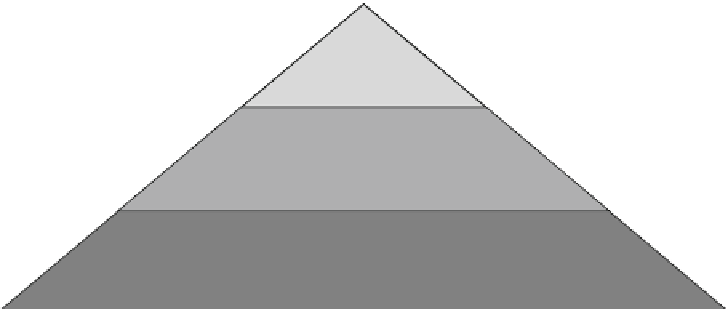Biomedical Engineering Reference
In-Depth Information
be changed by boundary conditions and constraints im-
posed by the engineer (i.e., interventions). These con-
cepts are analogous to moral development. At the most
basic level, a person's path toward moral decision making
is a continuum. Since much of an engineer's ethics is
influenced by his or her own ''conscience,'' a basic un-
derstanding of the theory of moral development is in
order.
43
''Conscience'' is something that develops rather rap-
idly in human development, but is honed constantly
throughout life. As a child learns to communicate, es-
pecially with the first caregivers, the conscience is
controlled and informed by external sources (i.e., we
learn to do what we are told by an authority figure, or we
learn by watching and imitating others). However, as
we mature, the conscience to a greater extent is controlled
internally. A mature conscience is the result of inter-
nalization. In other words, we start to depend completely
on outside sources, grow to become independent, but
eventually
Individual, personal conscience is the building block for
what the seventeenth century natural philosopher
Thomas Hobbes considered to be needed in a ''social
contract.'' Hobbes argued that humans are egoistic and
self-serving by nature, so an efficient society first in-
structs its individual members to behave in ways that
support the community. Hobbes thought that society had
to overcome the ''state of nature'' where selfish, brutish
individual desires would lead to anarchy. This argument
sees the role of conscience as twofold: to benefit the in-
dividual member (private conscience) and to benefit the
society as a whole (the commonwealth).
Character.
As mentioned in Chapter 8.1, Jean Piaget,
Lawrence Kohlberg, and other educational psycholo-
gists have argued that moral development takes a
predictable and stepwise progression. The development
is the result of social interactions over time. For ex-
ample, Kohlberg
45
identified six stages in three levels
(see Table 8.1-2.)
Kohlberg insisted that these steps are progressive.
Every person must pass through the preceding step
before advancing to the next. Thus, a person first behaves
according to authority (stages 1 and 2), then according to
approval (stages 3 and 4), before finally maturing to the
point where they are genuinely interested in the welfare
of others. My experience has been gratifying in that most
of my colleagues and the majority of engineering students
in my courses have indicated moral development well
within the postconventional level.
We can apply the Kohlberg model directly to the en-
gineering profession (
Figure 8.2-8
). The most basic
(bottom tier) actions are preconditional; that is, engi-
neering decisions are made solely to stay out of trouble.
While proscriptions against unethical behavior at this
level are effective, the training, mentorship, and other
behave
as
interdependent
members
of
a
community.
Another doctrine repugnant to Civil Society is, that
whatsoever a man does against his Conscience is Sin;
For a man's Conscience, and his Judgment is the same
thing; and as the Judgment, so also the Conscience
maybeerroneous;onceamanlivesin
acommonwealth,theLawisthepublicConscience,
by which he hath already undertaken to be guided.
Otherwise in such diversity, as there is of private
Consciences, which are but private opinions, the
Commonwealth must needs be distracted, and no man
dare to obey the Sovereign Power, farther than it shall
seem good in his own eyes.
Thomas Hobbes (1660)
44
Kohlberg's theory
Proposed model for
of moral development
Engineering decision making
Post-conventional level:
Macroethical concerns:
Concern for wider society;
Future generations;
distant peopled;
contingent impacts (critical paths);
advancing state of the science
universal ethical principles
Conventional level:
Concern about peers;
concern about community
Mesoethical concerns:
Company and stockholder interests; other
important stakeholders include customers,
suppliers, and employees
Preconventional level:
Microethcial concerns:
Legal constraints;
personal ethical considerations
Avoid punishment
Figure 8.2-8 Adaptation of Kohlberg's stages of moral development to the ethical expectations and growth in the engineering profession.





